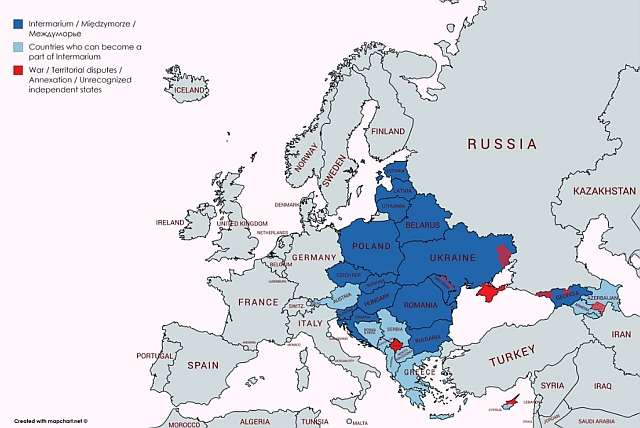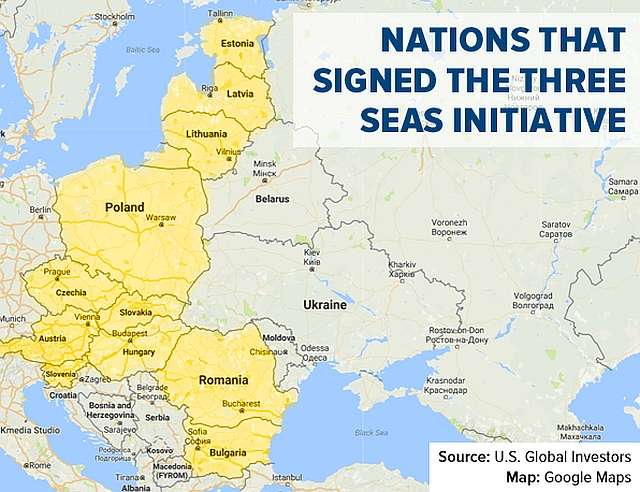"The Intermarium strategy was developed in Poland as a political doctrine at the turn of the 20th century. It was an attempt to answer the general question on how to rebuild a sovereign Polish state and how to secure its future. The concept was innovative even if the purpose was not. The Poles alone, and Poland as a sole actor, wouldn’t be able to achieve such a goal. Poland’s enemies, especially Russia, were considered the main obstacle to independence and excessively powerful. The authors of the Intermarium strategy, Józef Piłsudski and his closest associates of the Polish Socialist Party, discovered the potential of nationalistic aspirations of other nations living within the Russian state. The idea was simple: to initiate a national revolt in a suitable moment and split Russia along national divisions. In such a way both major Polish goals would be fulfilled: independence and a secure future. Russia, if pushed from Europe and stripped of its conquest, would be annihilated as an empire and no longer pose a threat to the newly established states.
The first opportunity to turn Intermarium strategy into reality appeared at the outbreak of the war between Russia and Japan in 1904. Piłsudski submitted his political study and idea to the Japanese ministry of foreign affairs. But the Japanese did not take that proposal seriously. The second opportunity emerged at the end of the First World War, which left Poland’s partitioners (Russia, Germany and Austria) defeated. Russia was additionally crippled by the revolution and civil war. Piłsudski wanted to create a chain of sovereign nation states from the Baltic Sea up to the Black Sea including Poland, Lithuania (heirs of the Grand Duchy in its 18th century borders), Ukraine, Latvia, Estonia and some countries in the Caucasus. All these nations working together within a political bloc were supposed to fundamentally transform Eastern Europe and bring a new strategic balance not only to the region, but also to the whole Europe. It is evident that the Intermarium project was directed against Russian power. Such a bloc would also prevent Germany from rebuilding its imperial might in Europe. Finally, newly established countries would become good allies to the Western European powers.
For achieving his goal Piłsudski needed two preconditions: complete military defeat of Russia and deep co-operation of the nations involved in the project. Neither came into place. The Riga Peace Treaty (1921) was a disaster for the Intermarium concept. It sanctioned a de facto partition of Ukraine and Belarus between Russia and Poland as well as ruined the relations of Poland with the other countries in the region. No nation was willing at that time to recognise Polish political aspirations nor were they willing to replace one colonial power for another;all of the neighbors were afraid of Polish domination. Additionally, the West treated Polish ambitions and activities as unjustified expansion to the East. Russia, on the other hand, was humiliated by the war with Poland and abandoned by the old entente allies. It started to look for new friends, such as Germany. The alliance was profitable for both sides. However, this change of international balance was achieved at the expense of all the nations settled between Germany and Russia. The new war broke out in 1939 and after five terrible years Germany was defeated, but the Soviet Union celebrated victory. The Yalta agreement allowed the USSR to swallow the whole disputed region in its direct and indirect sphere of influences.
In the post-war era, Intermarium was deeply buried and censored. Outside of the region it was cultivated by Polish exiles, for instance by Jerzy Giedroyć and his magazine Kultura. Giedroyć once stated: “There can be no free Poland without free Lithuania, Belarus and Ukraine.” What was important here was that Giedroyć abandoned the concept of Poland in its historic, Jagiellonian borders and stressed the value of equal co-operation among partners in every respect. In such a way he addressed the Eastern European nations’ pre-war fears of Polish domination.
This stance was supported and repeated by the Polish democratic opposition, which matured in the 1970s. In September 1981 the First National Conference of the Delegates of NSZZ “Solidarność” prepared a “Message to the working people of Eastern Europe”repeating Giedroyć’s position. The communist regimes were furious. The Soviet government treated the message as unauthorized interference into state policy. The Intermarium concept was still treated as a danger to Soviet rule over the region.
One could believe that after the dreams of many people in the region were realized and the Soviet Union collapsed in 1991, the Intermarium project would have been reintroduced. However the majority had another dream: to make a geopolitical shift from the East to the West. The first step was gaining independence from the Soviet Union through the disbanding of the Warsaw Pact and the Council for Mutual Economic Assistance. In this action all the countries of the region were loyal and supportive to each other. However, when it came to the negotiations with NATO and the European Union, solidarity disappeared. Nations were lodging separate applications; there was constant competition and individual negotiations. The weakness of the Intermarium was laid bare. It consisted in the differences between the goals of the potential partners. Whenever it came to deciding between solidarity and individual benefits, the latter always won – also within Visѐgrad Group. If the countries of a similar level of development were not able to reach any vital agreement, what can be said about the post-Soviet dependents like Ukraine, Belarus, Georgia and others?
Nevertheless, Intermarium existed as a slogan, especially in Poland, to which right-wing politicians frequently referred in their speeches. For instance, this could be visible in the parliamentary debates after the annual address by the minister of foreign affairs. One may ask: What was the reason for such empathy? That might not be solely the attachment to the tradition and glorious history, though this element should also be considered. Paraphrasing US President Donald Trump’s slogan, the Polish right was still attracted by the idea of “making Poland big again”. But how? They neither favoured sticking to the mainstream, nor promoting close co-operation with the most developed EU countries.
The answer could be seen in the parliamentary debate of 2013. Witold Waszczykowski who was then a deputy to the parliament stressed the need to “regain the role as spokesman of the region” and “rebuild the autonomous region, e.g. Carpathian”. His colleague Arkadiusz Mularczyk added that Poland should become a leader and a representative of Eastern and Central Europe within the EU. Thus, the essential role foreseen for Poland was to build its position by being a leader of an autonomous region. The will of some politicians is not always easily transformed into real action, however. And it certanily is not so easy to become the leader of a regional group.
When a new idea, the so-called Three Seas Initiative, appeared in 2015 and was followed by two summits (first in Dubrovnik in 2016 and second in Warsaw in 2017), the old Polish strategies began to once again emerge. The old questions were also being re-formulated: Does Poland still aspire to play the role of regional leader and want to use the newest initiative for its own purposes? What is the real reason for the 12 countries of Central and Eastern Europe, all members of the EU, to unite around some common goals?..."
In 2015, Pilsudski's old dream resurfaced, under the name Three Seas Initiative (3SI), a geopolitical joint project by Poland and Croatia:
"...It acts as a forum between twelve European countries to strengthen trade, energy, infrastructure and political cooperation. It is also known as the BABS Initiative as the member countries border with three European Seas - Baltic, Adriatic and Black Sea.
The Three Seas or BABS Initiative comprises of twelve Eastern and Central European countries. This includes Poland, Croatia, Czech Republic, Hungary, Romania, Slovakia, Bulgaria, Estonia, Lithuania, Austria, Latvia, and Slovenia. Other than Austria, all the member countries were formerly Soviet-influenced communist countries and part of the former socialist group known as Eastern Bloc.
Six of these member countries, Austria, Croatia, Czech Republic, Hungary, Slovakia, and Slovenia, are Central European Defence Cooperation (CEDC) countries. The CEDC was formed in 2010 with the objective of developing and strengthening defense cooperation between the member countries. Except Austria, all CEDC member countries are also part of NATO. Apart from that, four of its member countries, Hungary, Poland, Czech Republic, and Slovakia, are into a cultural and political alliance known as the Visegrad Group or Visegrad Four since 1991.
Interestingly, seven member countries of this project, Hungary, Romania, Czech Republic, Slovakia, Latvia, Estonia, and Lithuania, were part of the Intermarium plan of Jozef Pilsudski of Poland, who proposed a federation of Baltic States after the end of World War I.
The first summit of the Three Seas Initiative was held on the 25th and 26th of August, 2016 in Dubrovnik (Croatia). It was headed by the Croatian President, Kolinda Grabar-Kitarovic. The member countries agreed on economic cooperation to strengthen economic activates, especially in the energy and infrastructure sector.
The Three Seas Business Forum was formed during the second summit of the initiative that was held on 6th and 7th July 2017 in Warsaw under the leadership of the Polish President, Andrzej Duda. This event was highly debated and highlighted internationally as it was attended by the American President Donald Trump.
The initiative provided a base for strategically important infrastructural projects, two of which stand prominently so far are the North-South Highway and the LNG Projects.
The North-South Highway project is part of the Three Seas Initiative. It will connect Lithuania, Poland, Slovakia, Hungary, Romania, Bulgaria and Greece. The proposed route will connect Klaipeda, which is an important seaport of Lithuania, located on the coast of Baltic Sea, to Thessaloniki, one of the most important trade hubs in Southeastern Europe. It will also help boost trades with Poland by providing Eastern Poland with a north-south route to connect with Central Europe.
Poland and Croatia took the initiative of building Liquefied Natural Gas (LNG) terminals in the Baltic Sea to fulfill gas requirements of the member countries. Poland has completed its LNG terminal already, while Croatia is expected to complete its terminal by 2019. The construction of a pipeline for LNG is also part of the project...
Better pay attention to Eastern Europe. With potentially 150 million people, The Three Seas Initiative is set to become a geopolitical power to be reckoned with. Once again, the spoiled, deluded nations of Western Europe find themselves cushioned from Eastern dangers by, if not a Polish buffer, then in any case a Polish-doctored buffer, for it is Poland which is the main inspiration and instigator of this novel project.
There may be another reason to rejoice - while Western Europe will, over the next decades, in all likelihood drown in islamization and insane unchequered Third World immigration, the Three Seas Initiative, composed of the far saner Eastern European countries, may very well escape that terrible fate.
In more than one way, 3SI may become to the Western World what Byzantium was to the whole of the Roman Empire: a place where the immensely valuable assets of a great culture, material and immaterial, will be preserved from harm and decay for a thousand years to come.
MFBB.


No comments:
Post a Comment